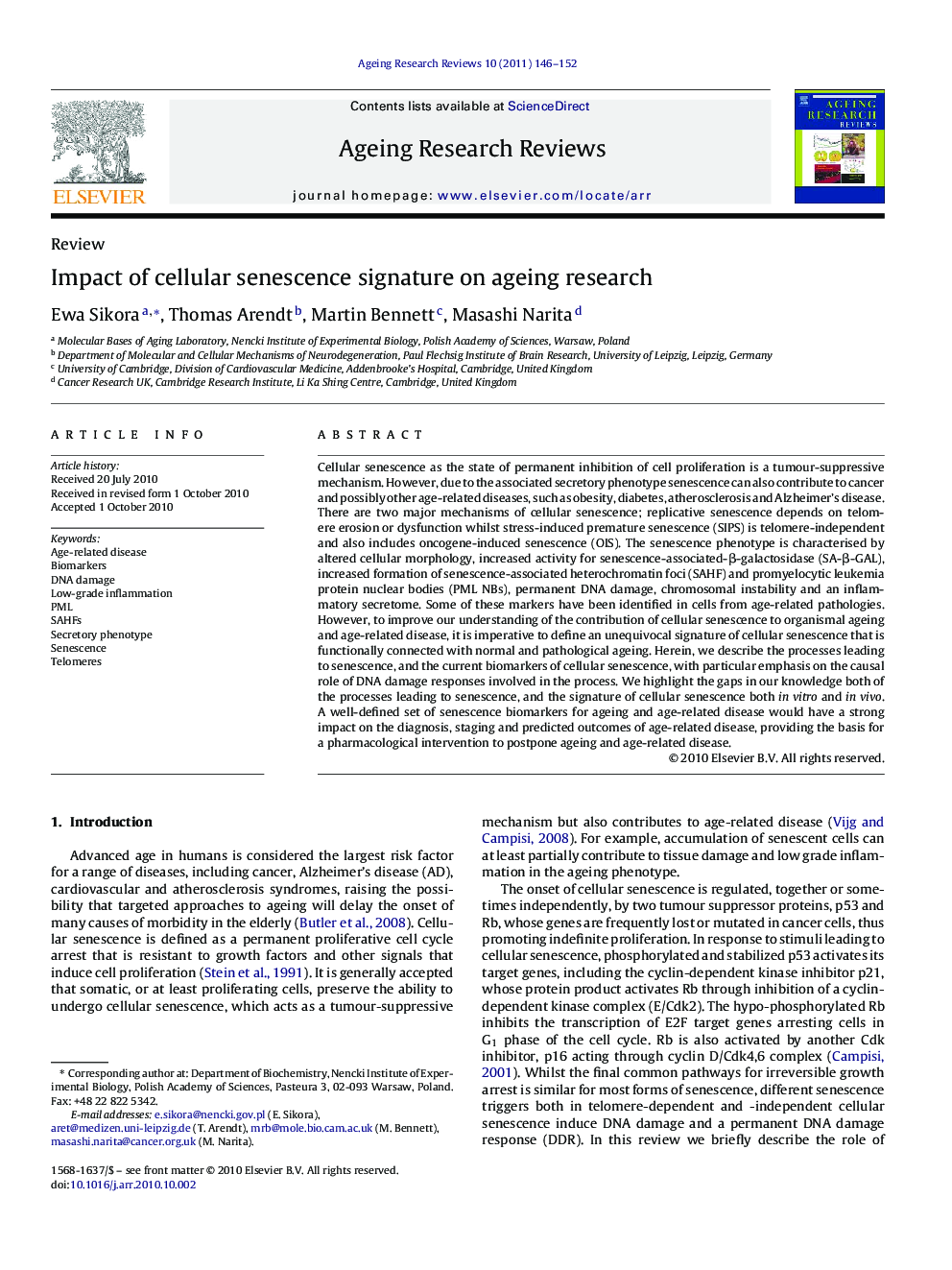| Article ID | Journal | Published Year | Pages | File Type |
|---|---|---|---|---|
| 1902390 | Ageing Research Reviews | 2011 | 7 Pages |
Cellular senescence as the state of permanent inhibition of cell proliferation is a tumour-suppressive mechanism. However, due to the associated secretory phenotype senescence can also contribute to cancer and possibly other age-related diseases, such as obesity, diabetes, atherosclerosis and Alzheimer's disease. There are two major mechanisms of cellular senescence; replicative senescence depends on telomere erosion or dysfunction whilst stress-induced premature senescence (SIPS) is telomere-independent and also includes oncogene-induced senescence (OIS). The senescence phenotype is characterised by altered cellular morphology, increased activity for senescence-associated-β-galactosidase (SA-β-GAL), increased formation of senescence-associated heterochromatin foci (SAHF) and promyelocytic leukemia protein nuclear bodies (PML NBs), permanent DNA damage, chromosomal instability and an inflammatory secretome. Some of these markers have been identified in cells from age-related pathologies. However, to improve our understanding of the contribution of cellular senescence to organismal ageing and age-related disease, it is imperative to define an unequivocal signature of cellular senescence that is functionally connected with normal and pathological ageing. Herein, we describe the processes leading to senescence, and the current biomarkers of cellular senescence, with particular emphasis on the causal role of DNA damage responses involved in the process. We highlight the gaps in our knowledge both of the processes leading to senescence, and the signature of cellular senescence both in vitro and in vivo. A well-defined set of senescence biomarkers for ageing and age-related disease would have a strong impact on the diagnosis, staging and predicted outcomes of age-related disease, providing the basis for a pharmacological intervention to postpone ageing and age-related disease.
Research highlights▶ There are two major mechanisms of cellular senescence; replicative senescence depends on telomere erosion or dysfunction whilst stress-induced premature senescence (SIPS) is telomere-independent and also includes oncogene-induced senescence (OIS). ▶ DNA damage response (DDR), which is induced by dysfunctional telomeres as well as DNA double-strand damage elsewhere in the genome, seems to be a crucial signalling pathway involved in cellular senescence. However whilst the link between DDR and mitosis in senescing cells may be critical for genomic instability, the role of telomeres is unclear. ▶ Further issues awaiting more in-depth studies are (i) the mechanism(s) of post-mitotic cell senescence, which may share more features with senescence of proliferating cells than previously expected, and (ii) the role of autophagy, a highly conserved mechanism and very efficient cellular response to stress. ▶ There are widespread gaps in our knowledge of both the mechanisms underlying senescence in normal ageing and disease and its pathophysiological significance. ▶ Although execution of both replicative senescence and SIPS is correlated with the appearance of several cellular markers, these senescence markers are incapable of unequivocally identifying senescent cells either in vitro or in vivo. ▶ To improve our understanding of the contribution of senescence to age-related diseases as well as normal ageing, it is imperative to identify a robust signature of cellular senescence.
